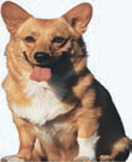

Today the choices of food for your Pembroke Welsh Corgi are many and varied. There are simply dozens of brands of food in all sorts of flavors and textures, ranging from puppy diets to those for seniors. There are even hypoallergenic and low-calorie diets available. Because your Pembroke’s food has a bearing on coat, health and temperament, it is essential that the most suitable diet is selected for a Pembroke of his age. It is fair to say, however, that even experienced owners can be perplexed by the enormous range of foods available. Only understanding what is best for your dog will help you reach an informed decision.
Dog foods are produced in three basic types: dry, semi-moist and canned. Dry foods are useful for the cost-conscious, for overall they tend to be less expensive than semi-moist or canned. Dry foods also contain the least fat and the most preservatives. In general, canned foods are made up of 60–70% water, while semi-moist ones often contain so much sugar that they are perhaps the least preferred by owners, even though their dogs seem to like them.
FEEDING TIPS
• Dog food must be served at room temperature, neither too hot nor too cold. Fresh water, changed often and served in a clean bowl, is mandatory, especially when feeding dry food.
• Never feed your dog from the table while you are eating, and never feed your dog leftovers from your own meal. They usually contain too much fat and seasoning. Human foods like chocolate and onions are toxic.
• Dogs must chew their food. Hard pellets are excellent; soups and stews are to be avoided.
• Don’t add leftovers or any extras to commercial dog food. The normal food is usually balanced, and adding something extra destroys the balance.
• Except for age-related changes, dogs do not require dietary variations. They can be fed the same diet, day after day, without their becoming bored or ill.
When selecting your dog’s diet, three stages of development must be considered: the puppy stage, the adult stage and the senior stage.
Puppies instinctively want to suck milk from their mother’s teats and a normal puppy will exhibit this behavior from just a few moments following birth. If puppies do not attempt to suckle within the first half-hour or so, they should be encouraged to do so by placing them on the nipples, having selected ones with plenty of milk. This early milk supply is important in providing colostrum to protect the puppies during the first eight to ten weeks of their lives. Although a mother’s milk is much better than any milk formula, despite there being some excellent ones available, if the puppies do not feed, the breeder will have to feed them by hand. For those with less experience, advice from a veterinarian is important so that not only the right quantity of milk is fed but also that of correct quality, fed at suitably frequent intervals, usually every two hours during the first few days of life.
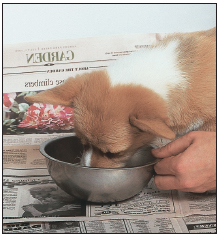
Puppies can be messy eaters! Consider lining your pup’s feeding area with newspaper or other absorbent material until he develops “table manners.”
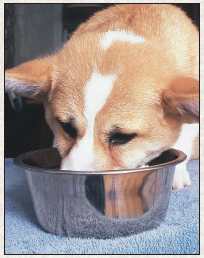
FOOD PREFERENCE
Selecting the best dry dog food is difficult. There is no majority consensus among veterinary scientists as to the value of nutrient analysis (protein, fat, fiber, moisture, ash, cholesterol, minerals, etc.). All agree that feeding trials are what matter most, but you also have to consider the individual dog. The dog’s weight, age and activity level, and what pleases his taste, all must be considered. It is probably best to take the advice of your veterinarian. Every dog has individual dietary requirements, and should be fed accordingly.
If your dog is fed a good dry food, he does not require supplements of meat or vegetables. Dogs do appreciate a little variety in their diets, so you may choose to stay with the same brand but vary the flavor. Alternatively, you may wish to add a little flavored stock to give a difference to the taste.
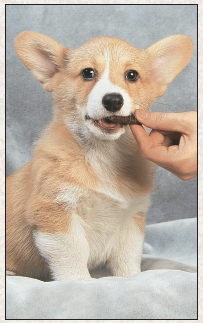
TIPPING THE SCALES
Good nutrition is vital to your dog’s health, but many people end up overfeeding or giving unnecessary supplements. Here are some common doggie diet don’ts:
• Adding milk, yogurt and cheese to your dog’s diet may seem like a good idea for coat and skin care, but dairy products are very fattening and can cause indigestion.
• Diets high in fat will not cause heart attacks in dogs but will certainly cause your dog to gain weight.
• Most importantly, don’t assume your dog will simply stop eating once he doesn’t need any more food. Given the chance, he will eat you out of house and home!
Puppies should be allowed to nurse from their mothers for about the first six weeks, although, from the third or fourth week, the breeder will begin to introduce small portions of suitable solid food. Most breeders like to introduce alternate milk and meat meals initially, building up to weaning time.
By the time the puppies are seven or a maximum of eight weeks old, they should be fully weaned and fed solely on a proprietary puppy food. Selection of the most suitable, good-quality diet at this time is essential, for a puppy’s fastest growth rate is during the first year of life. Veterinarians and breeders are able to offer advice in this regard. The frequency of meals will be reduced over time, and when a young dog has reached the age of about 12 months he can be switched to an adult diet.
Puppy and junior diets should be well balanced for the needs of your dog, so that, except in certain circumstances, additional vitamins, minerals and proteins will not be required.

Veterinary studies have proven that a balanced high-quality diet pays off in your dog’s coat quality, behavior and activity level. Invest in premium brands for the maximum payoff with your dog.
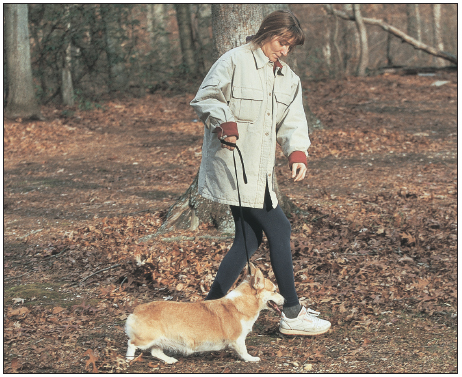
Proper diet combined with regular exercise will keep your Pembroke in top shape. This active little dog needs balanced nutrition for optimum “get-up-and-go.”
A dog is considered an adult when it has stopped growing. In general, the diet of a Pembroke can be changed to an adult one at about one year of age. Again you should rely upon your veterinarian or breeder to recommend an acceptable maintenance diet. Major dog food manufacturers specialize in this type of food, and it is merely necessary for you to select the one best suited to your dog’s needs. Active dogs have different requirements than more sedate dogs.
CHANGE IN DIET
As your dog’s caretaker, you know the importance of keeping his diet consistent, but sometimes when you run out of food or if you’re on vacation, you have to make a change quickly. Some dogs will experience digestive problems, but most will not. If you are planning on changing your dog’s menu, do so gradually to ensure that your dog will not have any problems. Over a period of four to five days, slowly add some new food to your dog’s old food, increasing the percentage of new food each day.
As dogs get older, their metabolism changes. The older dog usually exercises less, moves more slowly and sleeps more. This change in lifestyle and physiological performance requires a change in diet. Since these changes take place slowly, they might not be recognizable. What is easily recognizable is weight gain. By continuing to feed your dog an adult-maintenance diet when he is slowing down meta-bolically, he will gain weight. Obesity in an older dog compounds the health problems that already accompany old age.
As your dog gets older, few of his organs function up to par. The kidneys slow down and the intestines become less efficient. These age-related factors are best handled with a change in diet and a change in feeding schedule to give smaller portions that are more easily digested.
There is no single best diet for every older dog. While many dogs do well on light or senior diets, other dogs may do better on special premium diets such as lamb and rice. Be sensitive to your senior Pembroke’s diet and this will help control other problems that may arise with your old friend.
Just as your dog needs proper nutrition from his food, water is an essential “nutrient” as well. Water keeps the dog’s body properly hydrated and promotes normal function of the body’s systems. During housebreaking, it is necessary to keep an eye on how much water your Pembroke is drinking, but, once he is reliably trained, he should have access to clean fresh water at all times, especially if you feed dry food. Make certain that the dog’s water bowl is clean, and change the water often. Small water bowls are made especially to attach to the crate door and are recommended when your Pembroke is left in his crate for three or four hours at a time, or overnight.
DO DOGS HAVE TASTE BUDS?
Watching a dog “wolf” or gobble his food, seemingly without chewing, leads an owner to wonder whether his dog can taste anything. Yes, dogs have taste buds, with sensory perception of sweet, salty and sour. Puppies are born with fully mature taste buds.
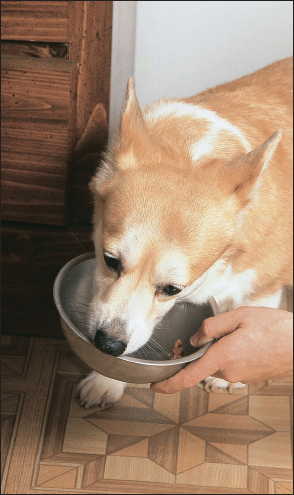
All dogs require some form of exercise, regardless of breed. A sedentary lifestyle is as harmful to a dog as it is to a person. The Pembroke is a fairly active breed that enjoys exercise, but you don’t have to be an Olympic athlete to provide your dog with sufficient exercise. Regular walks, play sessions in the fenced yard and letting the dog run free in a fenced enclosure under your supervision are sufficient forms of exercise for the Pembroke. For those who are more ambitious, you will find that your Pembroke will be able to keep up with you on extra-long walks or even occasional hikes. However, a Pembroke puppy needs time to grow up and develop stamina before you embark on strenuous forms of exercise such as overly long walks. Please note, if you are a runner, the Pembroke with his very short legs is not built to accompany you on your daily runs.
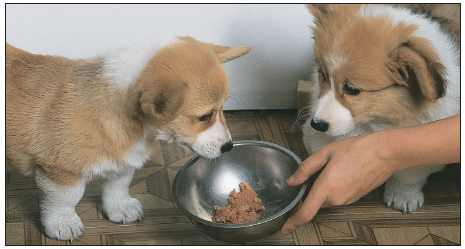
A puppy will have different nutritional requirements than an adult; however, you will be able to find a balanced dog food for each stage of your Pembroke’s life.
“DOES THIS COLLAR MAKE ME LOOK FAT?”
While humans may obsess about how they look and how trim their bodies are, many people believe that extra weight on their dogs is a good thing. The truth is, pets should not be over-or under-weight, as both can lead to or signal sickness. In order to tell how fit your pet is, run your hands over his ribs. Are his ribs buried under a layer of fat or are they sticking out considerably? If your pet is within his normal weight range, you should be able to feel the ribs easily, but they should not protrude abnormally. If you stand above him, the outline of his body should resemble an hourglass. Some breeds do tend to be leaner while some are a bit stockier, but making sure your dog is the right weight for his breed will certainly contribute to his good health.
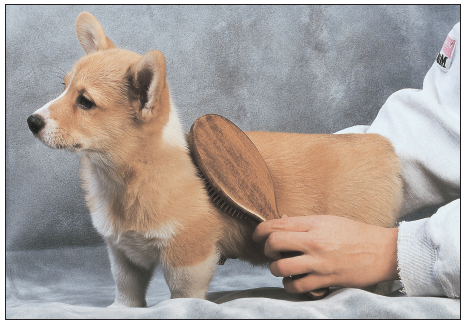
A brush with soft natural bristles can be used on the puppy coat. Accustom the young Pembroke to short daily brushing sessions.
Bear in mind that an overweight dog should never be suddenly over-exercised; instead, he should be encouraged to increase exercise slowly. Also remember that not only is exercise essential to keep the dog’s body fit, it is essential to his mental well-being. A bored dog will find something to do, which often manifests itself in some type of destructive behavior. In this sense, exercise is just as essential for the owner’s mental well-being!
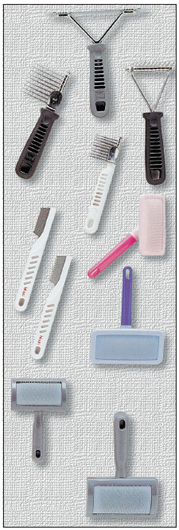
PHOTO COURTESY OF MIKKI PET PRODUCTS.
Invest in quality basics that will last you and your Pembroke for many years of use.
BRUSHING
A natural bristle brush or a slicker brush can be used for regular routine brushing. Daily brushing is effective for removing dead hair and stimulating the dog’s natural oils to add shine and a healthy look to the coat. Although the Pembroke’s coat is short and close, it does require a five-minute once-over a few times a week to keep it looking its shiny best. Regular grooming sessions are also a good way to spend time with your dog. Many dogs grow to like the feel of being brushed and will enjoy the daily routine.
GROOMING EQUIPMENT
Your Pembroke is not a high-maintenance dog that requires a complex grooming routine. Here are some basics for keeping him looking great:
• Natural bristle brush
• Slicker brush
• Metal comb
• Scissors
• Rubber mat
• Dog shampoo
• Spray hose attachment
• Towels
• Ear cleaner
• Cotton balls
• Nail clippers
• Dental care products
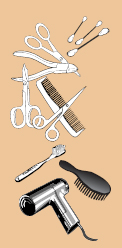
BATHING BEAUTY
Once you are sure that the dog is thoroughly rinsed, squeeze the excess water out of his coat with your hand and dry him with a heavy towel. You may choose to use a blow dryer on his coat or just let it dry naturally. In cold weather, never allow your dog outside with a wet coat.
There are “dry bath” products on the market, which are sprays and powders intended for spot cleaning, that can be used between regular baths if necessary. They are not substitutes for regular baths, but they are easy to use for touch-ups as they do not require rinsing.
Dogs do not need to be bathed as often as humans, but bathing as needed is essential for healthy skin and a healthy, shiny coat. Again, like most anything, if you accustom your pup to being bathed as a puppy, it will be second nature by the time he grows up. You want your dog to be at ease in the bath or else it could end up a wet, soapy, messy ordeal for both of you!
Brush your Pembroke thoroughly before wetting his coat. Make certain that your dog has a good non-slip surface to stand on. Begin by wetting the dog’s coat. A shower or hose attachment is necessary for thoroughly wetting and rinsing the coat. Check the water temperature to make sure that it is neither too hot nor too cold for the dog.
Next, apply shampoo to the dog’s coat and work it into a good lather. You should purchase a shampoo that is made for dogs. Do not use a product made for human hair. Wash the head last; you do not want shampoo to drip into the dog’s eyes while you are washing the rest of his body. Work the shampoo all the way down to the skin. You can use this opportunity to check the skin for any bumps, bites or other abnormalities. Do not neglect any area of the body—get all of the hard-to-reach places.
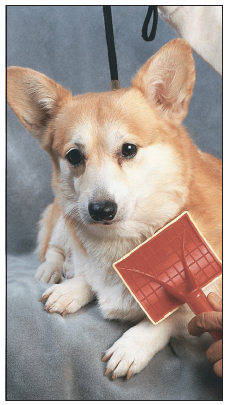
Regular brushing and combing will keep your Pembroke’s coat healthy and free of dead hair. A slicker brush like this is useful on the adult Pembroke.
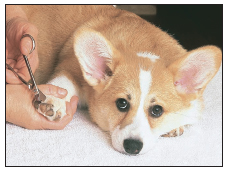
A “pedicure” is just part of the routine for this Pembroke. If you start trimming your dog’s nails when he is still a pup, he will quickly become comfortable with the procedure.
Once the dog has been thoroughly shampooed, he requires an equally thorough rinsing. Shampoo left in the coat can be irritating to the skin. Protect his eyes from the shampoo by shielding them with your hand and directing the flow of water in the opposite direction. You should also avoid getting water in the ear canal. Be prepared for your dog to shake out his coat—you might want to stand back, but make sure you have a hold on the dog to keep him from running through the house.
The ears should be kept clean with a cotton ball and ear powder or liquid made especially for dogs. Be on the lookout for any signs of infection or ear-mite infestation. If your Pembroke has been shaking his head or scratching at his ears frequently, this usually indicates a problem. If his ears have an unusual odor, this is a sure sign of mite infestation or infection, and a signal to have his ears checked by the vet.
PEDICURE TIP
A dog that spends a lot of time outside on a hard surface, such as cement or pavement, will have his nails naturally worn down and may not need to have them trimmed as often, except maybe in the colder months when he is not outside as much. Regardless, it is best to get your dog accustomed to this procedure at an early age so that he is used to it. Some dogs are especially sensitive about having their feet touched, but if a dog has experienced it since he was young, he should not be bothered by it.
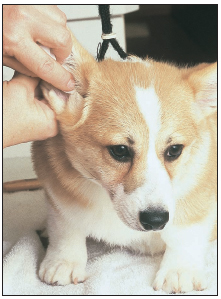
Clean the ears gently with soft cotton, checking for any abnormalities and never probing into the ear canal.
Your Pembroke should be accustomed to having his nails trimmed at an early age, since it will be part of your maintenance routine throughout his life. Not only does it look nicer, but long nails can scratch someone unintentionally. Also, a long nail has a better chance of ripping and bleeding, or of causing the feet to spread. A good rule of thumb is that if you can hear your dog’s nails’ clicking on the floor when he walks, his nails are too long.
Before you start cutting, make sure you can identify the “quick” in each nail. The quick is a blood vessel that runs through the center of each nail and grows rather close to the end. It will bleed if accidentally cut, which will be quite painful for the dog as it contains nerve endings. Keep some type of clotting agent on hand, such as a styptic pencil or styptic powder (the type used for shaving). This will stop the bleeding quickly when applied to the end of the cut nail. Do not panic if you cut the quick, just stop the bleeding and talk soothingly to your dog. Once he has calmed down, move on to the next nail. It is better to clip a little at a time, particularly with dark-nailed dogs.
Hold your pup steady as you begin trimming his nails; you do not want him to make any sudden movements or run away. Talk to him soothingly and stroke him as you clip. Holding his foot in your hand, simply take off the end of each nail in one quick clip. You can purchase nail clippers that are specially made for dogs; you can probably find them wherever you buy pet supplies.
Nail Maintenance
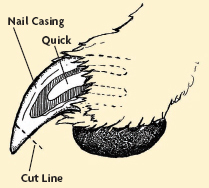
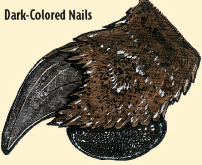
With black or dark nails, where the quick is not easy to see, it’s best to clip only the tip of the nail or to use a file.
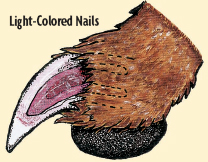
In light-colored nails, clipping is much simpler because you can see the vein (or quick) that grows inside the casing.
CAR TRAVEL
You should accustom your Pembroke to riding in a car at an early age. You may or may not take him in the car often, but at the very least he will need to go to the vet and you do not want these trips to be traumatic for the dog or troublesome for you. The safest way for a dog to ride in the car is in his crate. If he uses a crate in the house, you can use the same crate for travel.
Put the pup in the crate and see how he reacts. If he seems uneasy, you can have a passenger hold him on his lap while you drive. Another option is a specially made safety harness for dogs, which straps the dog in much like a seat belt. Do not let the dog roam loose in the vehicle—this is very dangerous! If you should stop short, your dog can be thrown and injured. If the dog starts climbing on you and pestering you while you are driving, you will not be able to concentrate on the road. It is an unsafe situation for everyone—human and canine.
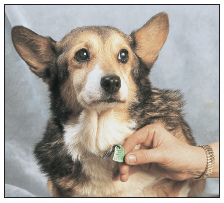
No matter how near or far from home you venture, keep your dog’s safety foremost. He should never leave home without proper identification.
TRAVEL TIPS
When traveling, never let your dog off-lead in a strange area. Your dog could run away out of fear, decide to chase a passing squirrel or cat or simply want to stretch his legs without restriction—if any of these happen, you might never see your canine friend again.
Never leave your dog alone in the car. In hot weather, your dog can die from the high temperature inside a closed vehicle; even a car parked in the shade can heat up very quickly. Leaving the window open is dangerous as well since the dog can hurt himself trying to get out.
For long trips, be prepared to stop to let the dog relieve himself. Take with you whatever you need to clean up after him, including some paper towels and perhaps some old rags for use should he have a potty accident in the car or suffer from motion sickness.
Contact your chosen airline before proceeding with travel plans that include Pembroke. The dog will be required to travel in a fiberglass crate and you should always check in advance with the airline regarding specific requirements for the crate’s size, type and labeling, as well as any travel restrictions and health certificates needed for the dog.
To help put your Pembroke at ease for the trip, be sure he is well acclimated to the crate in which he will be traveling, and give him one of his favorite toys in the crate. Do not feed the dog for several hours prior to checking in so that you minimize his need to relieve himself. Some airlines require you to provide documentation as to when the dog was last fed. In any case, a light meal is best. For long trips, you will have to attach food and water bowls to the outside of the dog’s crate so that airline employees can tend to him between legs of the trip.
Make sure that your dog is properly identified and that your contact information appears on his ID tags and on his crate. Your Pembroke will travel in a different area of the plane than the human passengers, so every rule must be strictly followed to prevent any risk of getting separated from your dog.
So you want to take a family vacation—and you want to include all members of the family. You would probably make arrangements for accommodations ahead of time anyway, but this is especially important when traveling with a dog. You do not want to make an overnight stop at the only place around for miles and find out that they do not allow dogs. Also, you do not want to reserve a place for your family without confirming that you are traveling with a dog because, if it is against the hotel’s policy, you may not have a place to stay.

Handy devices for “watering” your dog make it easy to keep your dog hydrated wherever you go.
COLLAR REQUIRED
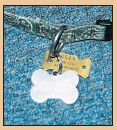
If your dog gets lost, he is not able to ask for directions home. Identification tags fastened to the collar give important information—the dog’s name, the owner’s name, the owner’s address and a telephone number where the owner can be reached. This makes it easy for whomever finds the dog to contact the owner and arrange to have the dog returned. An added advantage is that a person will be more likely to approach a lost dog who has ID tags on his collar; it tells the person that this is somebody’s pet rather than a stray. This is the easiest and fastest method of identification, provided that the tags stay on the collar and the collar stays on the dog.
Alternatively, if you are traveling and choose not to bring your Pembroke, you will have to make arrangements for him while you are away. Some options are to take him to a friend’s house to stay while you are gone, to have a trusted neighbor stop by often or stay at your house or to bring your dog to a reputable boarding kennel. If you choose to board him at a kennel, you should visit in advance to see the facilities, how clean they are and where the dogs are kept. Talk to some of the employees and see how they treat the dogs—do they spend time with the dogs, play with them, exercise them, etc.? Also find out the kennel’s policy on vaccinations and what they require. This is for all of the dogs’ safety, since when dogs are kept together, there is a greater risk of diseases being passed from dog to dog.
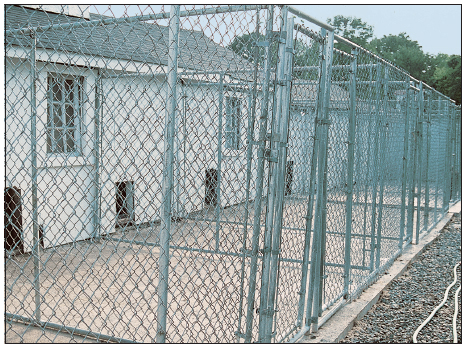
Research local boarding kennels before you need one. The kennel you choose should be large, clean and affordable, with a knowledgeable and caring staff.
Your Pembroke is your valued companion and friend. That is why you always keep a close eye on him and you have made sure that he cannot escape from the yard or wriggle out of his collar and run away from you. However, accidents can happen and there may come a time when your dog unexpectedly gets separated from you. If this unfortunate event should occur, the first thing on your mind will be finding him. Proper identification, including an ID tag and possibly a tattoo and/or microchip, will increase the chances of his being returned to you safely and quickly.
IDENTIFICATION OPTIONS
As puppies become more and more expensive, especially those puppies of high quality for showing and/or breeding, they have a greater chance of being stolen. The usual collar dog tag is, of course, easily removed. But there are two more permanent techniques that have become widely used for identifying dogs.
The puppy microchip implantation involves the injection of a small microchip, about the size of a corn kernel, under the skin of the dog. If your dog shows up at a clinic or shelter, or is offered for resale under less-than-savory circumstances, he can be positively identified by the microchip. The microchip is scanned, and a registry quickly identifies you as the owner.
Tattooing is done on various parts of the dog, from his belly to his ears. The number tattooed can be your telephone number, your dog’s registration number or any other number that you can easily memorize. When professional dog thieves see a tattooed dog, they usually lose interest. For the safety of our dogs, no laboratory facility or dog broker will accept a tattooed dog as stock.
Discuss microchipping and tattooing with your veterinarian and breeder. Some vets perform these services on their own premises for a reasonable fee. To ensure that your dog’s identification is effective, be certain that the dog is then properly registered with a legitimate national database.
